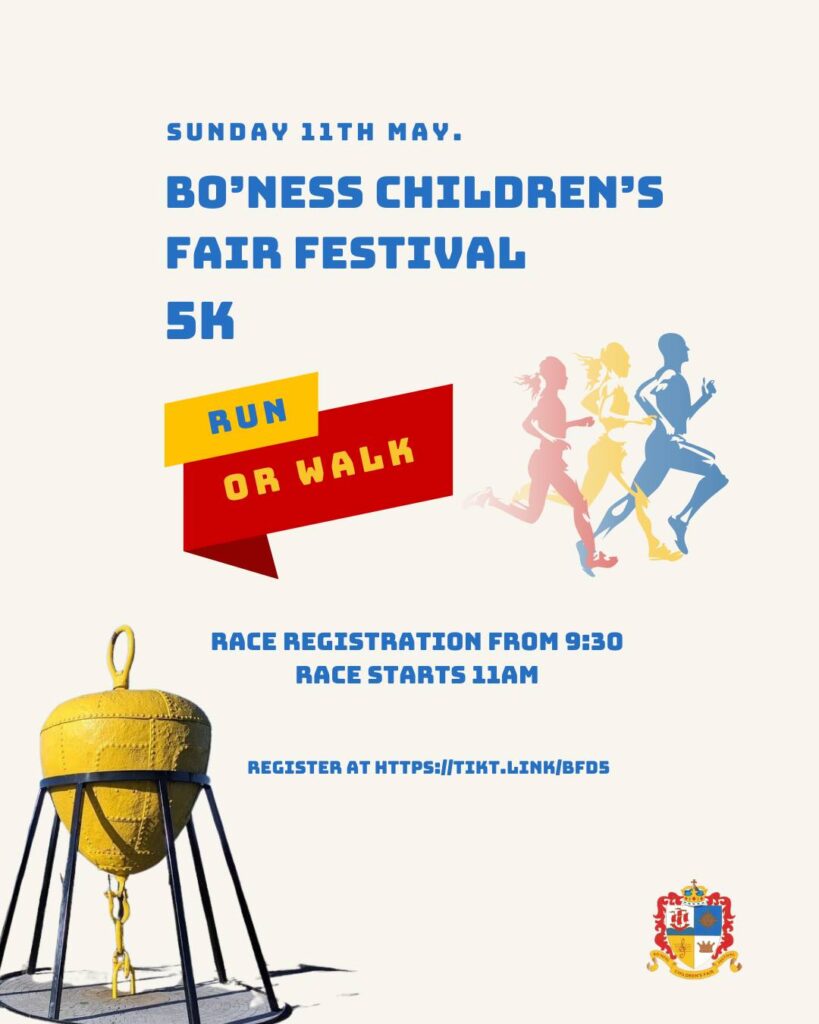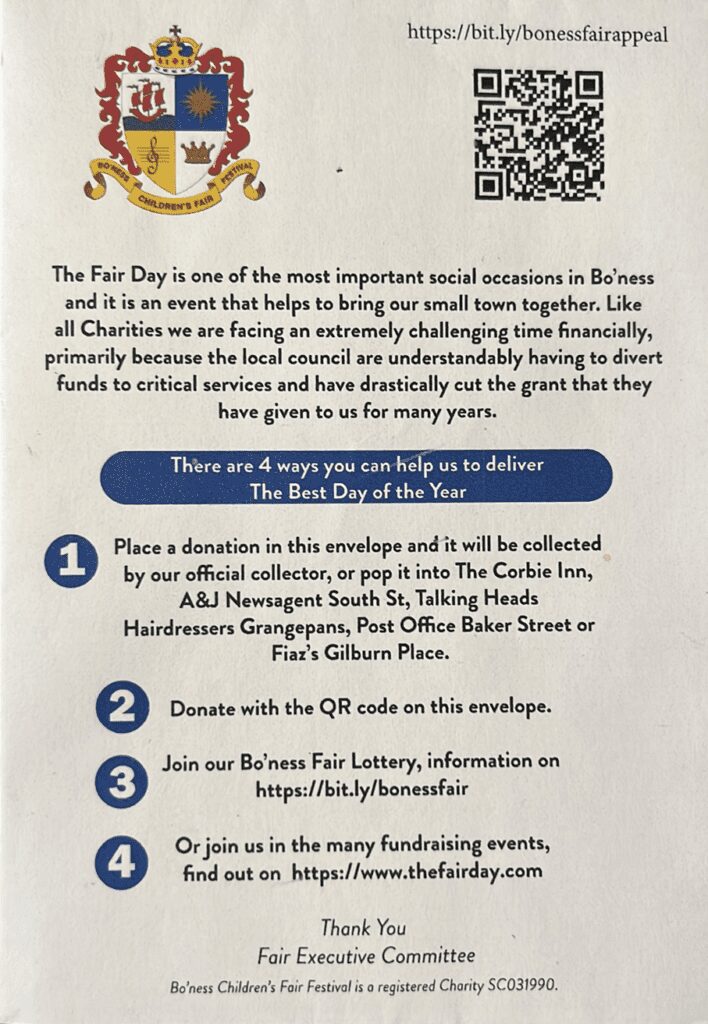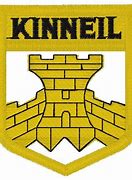To Bo’nessians, Bo’ness without its Fair would today seem inconceivable as Bo’ness without the River Forth or Bo’ness without its braes, yet at one time no self respecting person would have anything to do with the annual event, which is now the largest and most spectacular of its kind in the country. Unlike most of Scotland’s summer celebrations in towns throughout the Borders and Lowlands, which can trace origins to the traditional riding of the marches ceremonies or to old cattle fairs, Bo’ness Fair began, as one witness of the time described it, “as a drunken orgy” among the coal miners of the district.
Until the latter part of the 18th century, it was customary for all Scottish miners to be thirled, that is, bound to the pits, as were any children who were born to them while they worked in them. Thus the bondage was continued from generation to generation and if any of the miners tried to escape from virtual slavery the colliery masters had the power to send their overseers to drag them back and to punish them severely. Even when a colliery owner sold his pit, the miners were included as part of the transaction. At last, 1774, a law was passed forbidding the thirling of miners and their families to the coal pits, but those already tied to the mines were not granted their freedom straightaway and it was not until 1779 that an Act declared that, “all the colliers in that part of Great Britain called Scotland, are hereby declared to be free from their seritude.”
It was to celebrate this new-found liberty that the miners of Bo’ness who formed a very closeknit community of their own, staged their first Fair. From then on the Fair was held every year on the Friday in July which fell between the 12th and 19th, a date already connected with one of the four feeing fairs for which Anne, Duchess of Hamilton gained Parliamentary permission shortly after she won her battle for burgh status for Bo’ness in 1668.
On this, their only holiday in the whole year, all pit workers from the long, low miners’ rows at Borrowstoun and Newtown, marched down into the narrow winding streets of Bo’ness and on out through Corbiehall to Kinneil House, home of the Duke of Hamilton, who owned many of the local pits. In front of the big house, on its hilltop overlooking the River Forth, the miners, led their elected deacon, wearing his ornate, bonnet, sash and sword, were received by the Duke ‘s estate factor, who provided them all with glasses of whisky toddy.
From Kinneil the march continued, with frequent halts for refreshments, to the old Grange, the home of the other big colliery owner in Bo’ness, Mr. James John Cadell. Mr Cadell, himself, always welcomed his men and on this one day in the year it is reported that the “Maister” relaxed his usually severe manner and even handed round the whisky toddy to his miners, an act which greatly delighted them. A brass band, imported during the early years from Falkirk, always accompanied the marchers and while they enjoyed their free drinks, it played on the lawn in front of the old Grange, before leading them down to the banks of the Forth, where horse races were held on the foreshore, throughout the afternoon.
The most distinguished visitor to the Bo’ness races was Robert Burns, but he was little impressed with the standard of the races as he was with the rest of Bo’ness, which he descrbed as, “that dirty ugly place, Borrowstounness”, and which certainly did not inspire him to verse. It is little wonder that Burns was not thrilled by the races, for the mounts were just local carriage and wagon horses, pressed into service for the day and generally most of them had already done duty earlier in the day, carrying the Deacon and other miners’ leaders at the head of the procession.
Once the last race was over the crowd returned to Corbiehall, where the booths and side stalls of the fairground were set up and the ginger bread sellers did a roaring trade. Later there was dancing in the Town Hall, where all miners and their wives and daughters could afford to join in the merrymaking, as they paid separately for each dance at one penny a time.
Drinking, was however, the main attraction of the Fair and the town’s many pubs and inns were crowded. In those days there were no licensing laws and the pubs stayed open throughout the night so that the festivities continued right into the following Saturday, or at least as long as the miners’ money lasted. The remainder of the weekend the miners spent sobering up, returning to the pits to start work again early on the Monday morning. Their annual holiday was over and there was only the next year to look forward to, to brighten their dreary existence, so they immediately appointed a new Deacon to act as their leader and make a start to the arrangements for the following year’s Fair.
Gradually, as the years of Queen Victoria’s long reign passed, and the barriers between the coal miners and the other members of the community were slowly broken down, other workers in the town began to take part in the Fair and each of the trades found in Bo’ness was represented in the procession. One of the most interesting and colourful groups in the procession was made up by the craftsmen from the local potteries, for the potters always wore their white trousers, white aprons tied with balck ribbons, black tail coats and tall black lum hats and carried with them examples of their craft and symbols of their trade, including model china sailing ships, and miniature kilns.
Although for a time more of the townspeople took part in the festivities, as Queen Victoria’s reign wore on the Fair’s popularity began to wane partly because of the excessive drinking which took place at it and which shocked the more soberly minded citizens.
Finally, in 1894, the miners realised that something had to be done if their annual celebration was not to die out and so they approached the local Police Commissioners, who at this time governed Bo’ness, before the creation of a Town Council, and suggested that these gentlemen should take part in the Fair Procession. The very proposal caused consternation in the town and several of the Commissioners were opposed to associating themselves in any way with this day of drinking, one demanded to know whether they would be expected, “to get fou like the rest?” After long and heated discussions, however, Provost Ballantine persuaded his colleagues to join in the proceedings, on the strict understanding that they would be properly conducted.
Announcing their decision, Provost Ballantine stated grandly that he felt that, “It became the authorities of any place that, for one day at least, they should be on a level with their neighbours”, and that, therefore it was, “quite in keeping that the Commissioners of Bo’ness and others outside should for a few hours, join in the general friendship and forget any differences that have taken place.”
And so that year the parade was led usual by the miners’ Deacon, but he was followed by the Provost and the Commissioners in open landaux, flanked by scarlet-coated outriders and led by banner bearers proudly carrying a large banner depicting the Burgh Coat of Arms with its ship under full sail and on a scroll beneath it the town’s motto, “Sine Metu” – “Without Fear”.
At last a touch of pageantry had been added to Bo’ness Fair, but this was nothing compared to what was to come only three years later in 1897, at the time of Queen Victoria’s Diamond Jubilee, for the wave of celebrations, which swept across the country was seized by Provost Stewart as the ideal opportunity to bring the children of the town into the festivities for the first time. As his model he chose Lanark’s Lanimer Day, at which the boys and girls of the town elected one of their school friends to be their Fair Queen. The new-style Bo’ness Fair was received with great enthusiasm by the local people and first school girl “Queen”, Grace Strachan, chosen by the pupils of the old Anderson Academy, was cheered as she rode in her carriage in the first grand procession after her coronation, which was performed in Craigallen Park by Mrs Balfour, wife of the Chairman of the school Board.
From Craigallen the procession made its way out to the Kinnigars Park at Carriden, where the first Queen’s revels were held. The route took it down to the new Philpingstone Road, which was officially declared open by Mrs Cadell, before the Queen’s horse-drawn carriage entered it from Grange Terrace.
In all over 2,000 children from Bo’ness Infant School, Grangepans Infant School, Bo’ness Public School, Kinneil School, Borrowstoun School and Carriden School, as well as the Anderson Academy, took part in the first Fair. As well as Queen Grace, many of her classmates from the Old Academy and boys and girls from all the other schools played the parts of gaily dressed lords and ladies of the royal court and fairies, flower girls and other characters, just as their grandchildren and great grandchildren still do every summer.
At the new-style Fair the emphasis was now all on the children’s enjoyment and old horse races were replaced by a programme of revels, which included sports and selections of music played by both brass and pipe bands. These early revels, which were held alternately at Kinnigars and Kinneil, must have been very colourful affairs, for all the children, both boys and girls, wore scarlet, blue and yellow caps, according to their school colours and all the little girls were dressed in their new white Fair dresses, while the little boys were all turned out in white flannel shorts and white shirts.
For the children there was an added touch of excitement about the Fair because it always marked the start of the school holidays and that the long hot summer weeks of freedom lay ahead.
“THE MORN’S THE FAIR AND I’LL BE THERE, AND I’LL HAE UP MY CURLIE HAIR,”
chanted the little Bo’ness girls as they raced home from school on the Fair E’en to gaze yet again at the new white dresses and shoes, which they would wear for the first time the following morning.
Since Provost Stewart launched his new children’s day the pageant has been staged every summer apart from the years during the First and Second World wars and the Industrial depressions in 1921 and 1926 until today it is the largest and most popular event of its kind in the country.
As is but appropriate, the local miners whose ancestors started it all, still play at big part in the festivities and they are the acknowledged experts in the art of building the huge decorative arches, which span the roads in front of the homes of the Queen and her Chief Lady in Waiting. As well as the big arches with their castle-like towers and turrets, dozens of smaller versions are erected at the homes of the other children, who are playing characters in the Fair and a very high standard of workmanship and ingenuity is demanded by the judges before they award one of the coveted scarlet first prize tickets to either one of the traditional clipped greenery arches or one of the modern designs created from hardboard. To complete their arches in time for the judges’ tour of inspection early on the Fair Morning, many of the builders work throughout the night as do the other enthusiasts busy putting the finishing touches to the elaborate tableaux and decorated floats, which are always a highlight of the mile-long grand procession. Great rivalry exists among the tableaux builders and details are always kept as close a secret as possible until the big floats emerge on the Fair morning to make their slow way to the Chance Park for the judging ceremony.
The decorated lorries of today’s Fair keep alive a link with the old miners’ Fair, for in their procession the rear was always brought up by the local carters with their carts and horses gaily decorated for the occasion. Today horses, apart from the Champion’s mount have disappeared from the procession, but the old Bo’ness comment, “She’s all dressed up like a Fair horse” is still occasionally heard.
Tradition is also maintained in the coronation ceremony, which has changed very little over the years. Apart from the shortening of the original Herald’s proclamation and the increased importance of the young presentees, in fact, the only major change from the ceremony at which Queen Grace Strachan was crowned has been the introduction of the now famous Fair songs. In the very earliest of the Children’s Fairs the songs were always “Scots Wha Hae”, “Three Cheers for the Red, White and Blue” and “Auld Lang Syne”. The first of our present Fair songs was “Our Festal Day”, by Mr. R. Fleming, set to music by Mr. E. C. Schofield, and it proved so popular that a few years later, in 1903, “Hail to our Queen” by Mr. Hope A. Thomson, with music by Mr. L. Dyer Appleby, was added to the proceedings. Over the last sixty years these two songs have become very dear to the hearts of Bo’nessians and they have been sung wherever they meet, even at Hampden park, Glasgow, when Bo’ness United won the final of the Scottish Junior Cup.
To begin with, the new Fair songs were always played by a quartette made up of “Baker’s Rab” Robert Snedden, W. Robertson, D. Sneddon and that grand old man of Kinneil Band, T. Gow Robertson. Now they are played by either the full Kinneil or Carriden Bands, which, along with seven other pipe and brass bands, play such a big part in the Fair, from the moment of the Queen’s revels, now held in the Douglas Park.
The importance of the bands in the Fair proceedings has now been recognised by the introduction into Festivities of an open brass band contest which attracts leading bands from all parts of Scotland. Music from even further a field has been introduced by the invitation to the Fair of overseas school bands, singers and dancers from Norway, Russia, Poland and Canada. The inclusion of these international groups is typical of the new enthusiasm which has brought an added spectacle to the Fair during the past few years. Now the full range of Fair activities includes Kirkin’ of the Queen Ceremony, school sports tournaments, the open air brass band contest, and a torchlight procession on the Fair E’en.
The Fair proceedings themselves have taken on a new glitter, thanks to the provision of a new crown, sceptre and robes, all made by top Scottish craftsmen, and bought as a result of the tremendous response to a local appeal. A new glamour has also come to the grand procession with the introduction of continental style tableaux for the Queen, her retinue and the fairies and flower girls, to complete the modern image the revels have now been transformed into a spectacular Royal Command Performance. For over two hours Scotland’s foremost stage and television personalities appear before our Fair Queen and an audience of over 20,000 people.
It is in this atmosphere that our Tercentenary Year Fair will take place and as the sound of over 3,000 school children singing “Our Festal Day” rises high above the River Forth, everyone of the huge crowd assembled in the Glebe Park will know that yet another Fair is nearing its climax. As the hands of the big Town Hall clock move steadily towards 11 o’clock, the boy Champion will issue his traditional Challenge,
“IF ANYONE HERE SHALL DENY THE QUEEN’S TITLE TO THE THRONE, I AM HERE, READY TO DEFEND IT , IN SINGLE COMBAT.”
Then, exactly as the hour chimes out, Queen Marjory will be crowned; the moment for which she has trained for over three months will have arrived; the moment she will never forget, for she will know that, on this June Friday morning, her home town is paying her what has become it’s highest honour.
UNKNOWN






